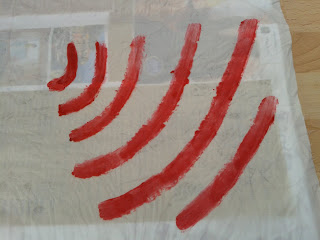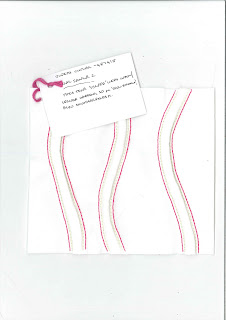Here are my thoughts and responses to the questions posed under "What have you achieved?" at the end of Assignment 1
- did you feel that your finished samples fulfilled the project theme that you chose to work with? did you make the right choices and decisions when selecting at each stage of the project? If not what would you change and how would you alter the outcome?
I feel happy to answer this question with a 'yes' because in the end I chose a theme that was personal for and to me. My choices and decisions were therefore direct, ie did
I like the result? could
I live with this? However, this would have been more difficult if the project had been for a third party. Plus the information provided in the assignment was very limited, giving little practical information that would be essential if you were carryuing out the project for a third party.
For example I have assumed that I was making samples for fabrics that I would be creating, but this could easily not have been so, in which case practical decisions would have needed to be made regarding cost, time, equipment, materials and so on. So in those circumstances then my answer could easily be no, I didn't make the right choices and decisions. However, I'm a practical person. So, even though I assumed the finished items would be made by me for me, I incorported questions like 'could I live with this for a long period of time?', 'would I like to make a larger piece of this?', and 'does this balance between being practical and unusual?' These questions and the answers to them were partly why I rejected using the cut away samples that I used, as in both cases they failed one or more of the questions.
Of course there were lots of techniques that I didn't try when doing my samples - printing on fabric for example - and there are those that could say that the omission of these techniques was a bad choice.
- can you see a clear line of progression from source material through to the finished sample pieces?
This is always an interesting question to answer, because obviously I'm close to the subject so might see something that others might find hard to observe. However, the curved lines were in the original observation study, and they continue through to my final samples. In the end I made a conscious decision to utilise a particular source of the curved lines (those in the Liscio logo) and not start to use other curves that were appearing. I aided this by bending my 'flexible curve' into a shape resembling them and did my best to keep to using this same shape through the initial sketching to the drawing of the curves on my final samples. In other words, I did my best to concentrate on one particular source area, and not go off at too many tangents, although I did look at some other potential ideas and incorporate a broader range of ideas for samples etc in my sketchbook. This was deliberate because one thing I have learnt in the past is that when you are creative it is far too easy to get drawn down too many potential paths and cul-de-sacs and become lost in a world of all the things you'd like to try. Obviously the more time that is available the less strict you have to be on this, and clearly you have to incorporate some variances in order to explore a theme, plus a lot of good ideas are often discovered as 'accidents'! However, I feel that what I am doing now is a bit like learning any new skill. You have to limit yourself and practice well at each level, gradually increasing your knowledge and confidence, however tempting it is to let those areas that interest you run on ahead without you building a strong enough foundation. This could of course just be my approach, but at this time I think it is the best one for me personally and will help me to achieve what I need to achieve in order to complete the course.
- how useful was the initial 'brainstorming' exercise and assembling of the word list in stimulating your imagination and in helping you to define and focus on an atmosphere or mood?
I think an exercise such as this is always useful provided you do just 'brainstorm' and quickly jot down what comes to mind rather than worry over it. I literally put down in words the thoughts that were in my head.
- how important was the choice of fibre in terms of determining the qualities that you achieved?
I deliberately restricted myself to only a limited range of fibres for this project. I stuck to the same main fabric and all of the samples are produced using a small range of additional fabrics or threads. I think this arose from the fact that my theme led me to look for a simplistic result. Less is more in this case, the interest being created by the curved shapes and the contrast between the white the the splashes of colour and texture. That approach fitted this project. Another project could be totally different. For example, if I'd been inspired by the curves but not used the colour palette nor the modern essence of the building I could have used lots of lovely textured fabrics and threads in gold, bronze and brown (some of my favouite colours!) to create something totally different.
- how important was the use of colour in this project to create the right atmosphere or mood?
To me colour is always important! However, in this instance it wasn't so much the use of colour, but rather the selective use of colour in a limited way that was necessary to create the right atmosphere or mood. Less was more, and only one of my final samples is fully coloured, chosen to compliment the other two samples which are basically plain with coloured highlights. I saw this as a key element when choosing which samples I would put together to be my final three.
- did you find it difficult to co-ordinate your samples so that they could be used together in some way?
No, I didn't. I think that having followed the process through the resulting choices work well together. That is not to say that I couldn't have created several variations even of the final three samples to give more options that could work together, of course!
- how do you envisage your samples being used in your chosen environment?
Final sample 1
I envisaged this sample as being used for curtains any any other areas where drape was required. That said, as can be seen from my test samples I did create a version in another colour way (ie lime main, pink stitching) that demonstrates that this could be used for an insert in a cushion cover for example.
Final sample 2
This sample has a 3d look, so would look really good where that could be seen. Again it could make a good cushion cover - one that you probably wanted to touch! It might look interesting as a lamp shade. If it was decided to use final sample 1 as a net curtain, then this sample could make an interesting curtain to go with it. I did think at one point that it could be used to make a fascinating wall hanging, with the 3d effect creating small shadows.
Final sample 3
This is the sample that I see being used to make chair covers, table cloths and that sort of thing, where sample 1 would probably stretch too much and the holes would prove a nuisance (fingers and buttons on clothing getting stuck in them) and the raised ridges in sample 2 would either be uncomfortable to sit on or become squashed with constant use. Of course the curved stripes don't have to be all over - nor do those in sample 2, and for that matter strips of sample 1 could be used as inserts into curtains alongside just the plain fabric/strips of fabric based on samples 2 or 3. The whole point of making co-ordinating fabrics is that they suggest options for mixing and matching!















